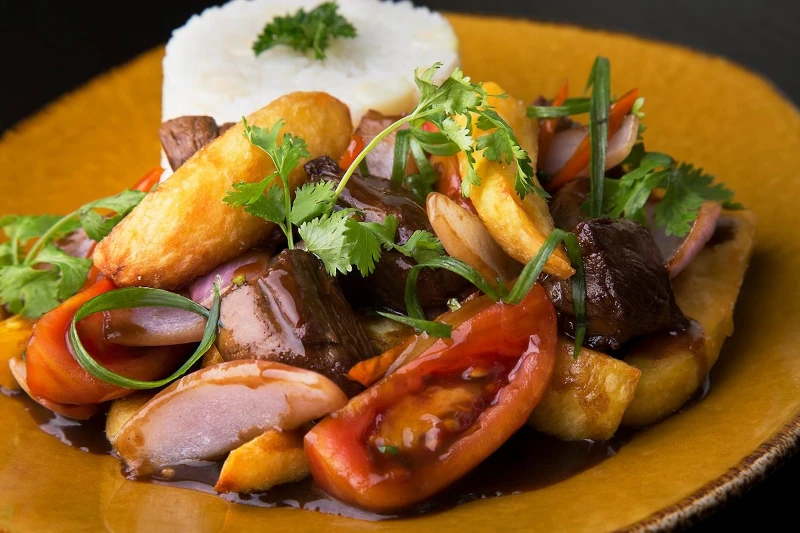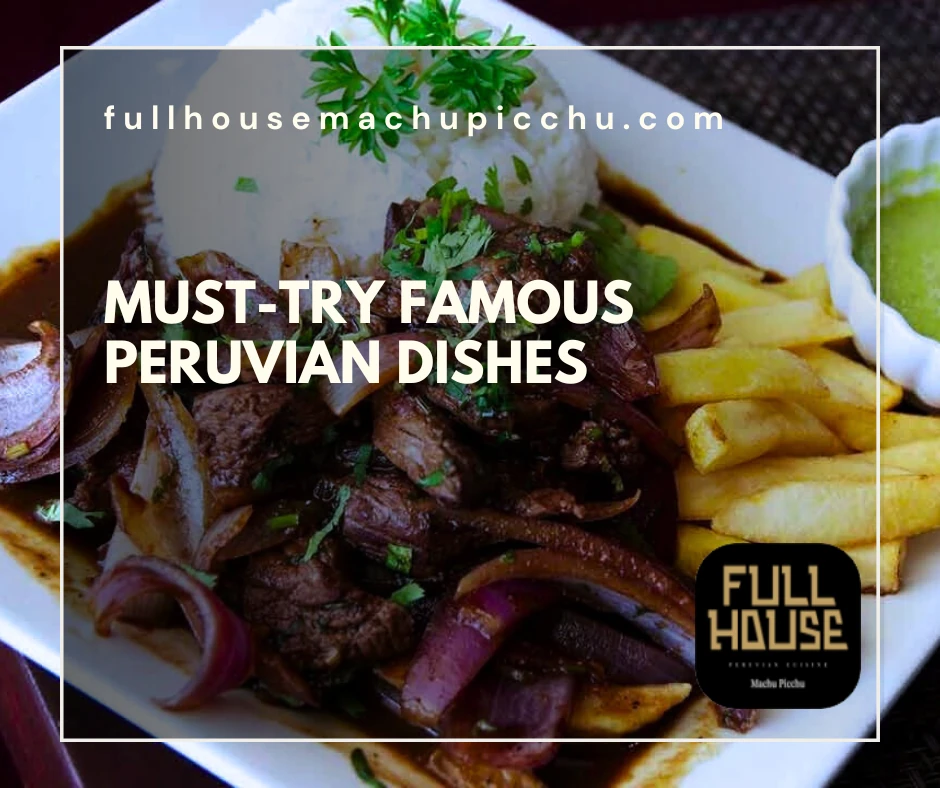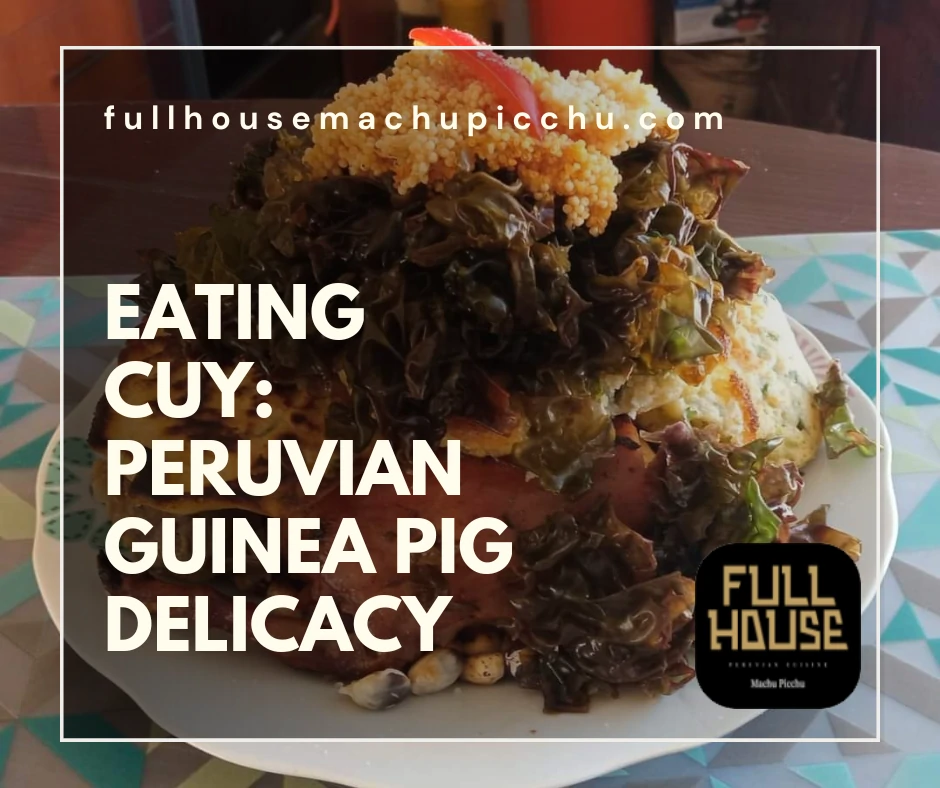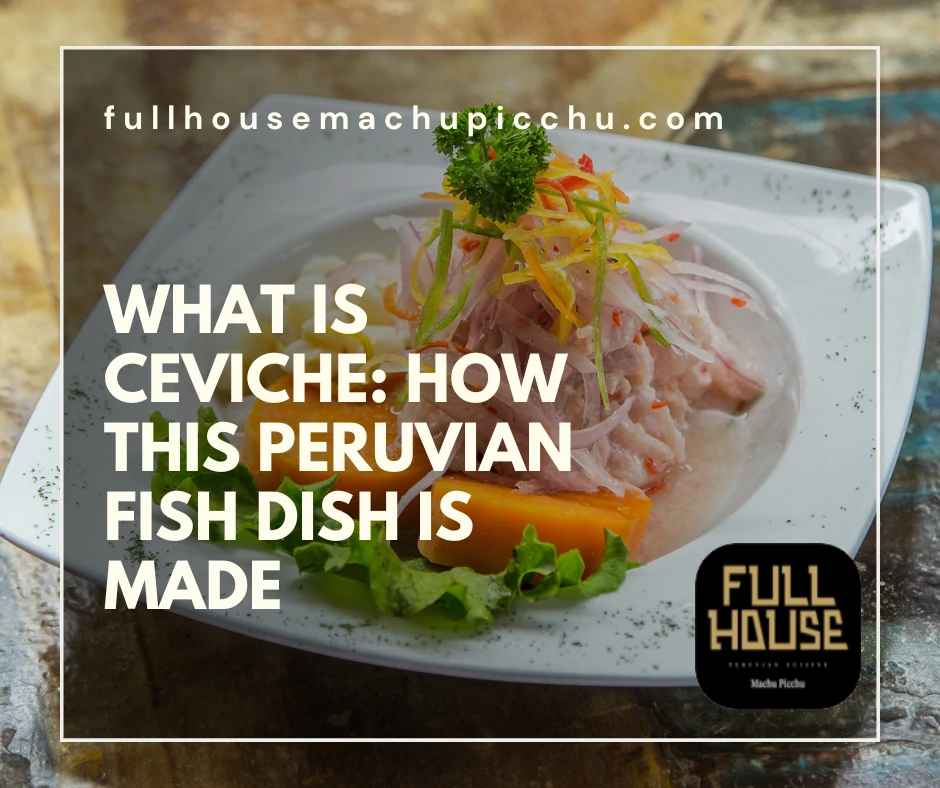Peru, a land of rich history and diverse landscapes, is also a culinary paradise. Its cuisine, a vibrant tapestry of flavors, is as diverse as the country itself. The famous Peruvian dishes are a delightful blend of indigenous traditions and foreign influences.
They reflect the country’s multicultural heritage, with Spanish, African, Asian, and Italian elements. The country’s diverse microclimates contribute to a wide array of ingredients.
Peru’s food is diverse. It includes seafood from the coast, tubers from the Andes, and fruits from the Amazon. This variety shapes Peru’s culinary identity.
In this guide, we’ll explore the must-try famous Peruvian dishes. We’ll delve into the cultural significance of each dish and its place in Peruvian society.
From the national dish, Ceviche, to the fusion favorite, Lomo Saltado, we’ll take you on a culinary journey. We’ll also touch upon the country’s signature cocktail, Pisco Sour, and the staple grains like Quinoa.
We’ll also discuss the importance of sustainable gastronomy in Peru. Highlight the country’s commitment to supporting local farmers and using native ingredients.
So, whether you’re a food enthusiast or planning a trip to Peru, this guide is your passport to the flavors of Peru. Let’s embark on this Peruvian typical dishes adventure together.
The Rich Tapestry of Peruvian Cuisine
Peruvian cuisine is a fascinating blend of cultures and flavors. It’s a culinary journey that tells the story of Peru’s rich history and diverse landscapes. Some of the best peruvian dishes are fusions and mixes from other cultures.
The cuisine is deeply in the country’s indigenous traditions. The Incas, Peru’s ancient civilization, significantly influenced the food culture. They introduced staple crops like potatoes, corn, and quinoa.
Over time, foreign influences added new dimensions to Peruvian traditional foods. Spanish colonizers brought livestock, rice, and wheat. African, Chinese, and Japanese immigrants introduced new cooking techniques and ingredients.
Today, Peruvian cuisine is a delightful fusion of these influences. It’s a testament to the country’s history of immigration and cultural exchange.
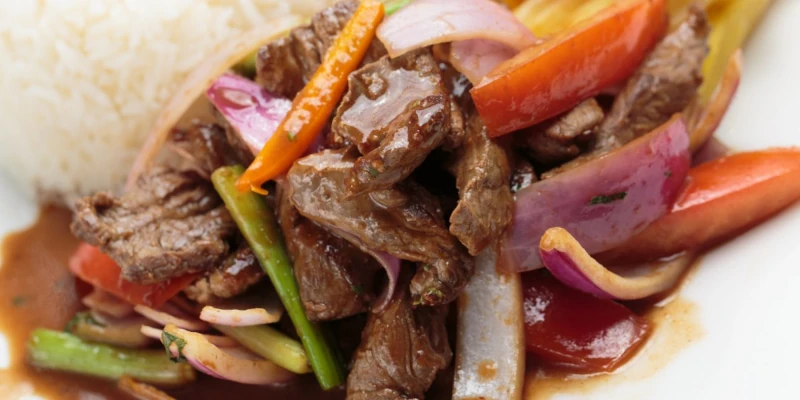
The Cultural Melting Pot of Flavors
Peruvian dishes are a symphony of flavors. They strike a balance between spicy, sour, sweet, and savory.
The use of aji peppers is a hallmark of Peruvian cooking. These peppers add a flavorful heat to dishes. Lime is another common ingredient, adding a bright acidity.
Peruvian food also features a variety of tubers, grains, and legumes. Potatoes, corn, and quinoa are staples in many dishes. Rice and beans, introduced by the Spanish and Africans, are also common.
The fusion of these flavors and ingredients creates a unique culinary identity. It’s a reflection of Peru’s multicultural heritage and its rich biodiversity.
Peru’s Biodiversity and Its Impact on Famous Peruvian Dishes
Peru’s diverse landscapes contribute to its culinary richness. The country boasts a variety of microclimates, each with its unique flora and fauna.
The coastal region is renowned for its fresh seafood. It’s the birthplace of Ceviche, Peru’s national dish. The Andean highlands are home to thousands of potato varieties and superfoods like quinoa.
The Amazon rainforest offers unique fruits, yuca, and plantains. These ingredients are central to the region’s unique culinary traditions.
This biodiversity is a cornerstone of Peruvian cuisine. It allows for a wide array of ingredients, contributing to the country’s gastronomic diversity.
Ceviche: The National Dish of Peru
Ceviche is the crown jewel of Peruvian cuisine. It’s a dish that perfectly captures the country’s coastal bounty and culinary ingenuity. Is one of the main dishes in Peru for every visitor.
At its core, ceviche is a simple dish. It’s made with fresh raw fish, cured in citrus juices. The acid in the juice “cooks” the fish, giving it a tender texture.
The fish is typically marinated with aji amarillo, a yellow Peruvian pepper. It’s then mixed with onions, salt, and cilantro. The result is a dish that’s tangy, spicy, and incredibly refreshing.
Ceviche is more than just a dish in Peru. It’s a symbol of national pride and a testament to the country’s rich seafood tradition.
Aji de Gallina: A Creamy Peruvian Classic
Aji de gallina is a beloved Peruvian dish that warms the soul. It’s a creamy chicken stew that’s as comforting as it is flavorful.
The star of the dish is aji amarillo, a yellow Peruvian pepper. It gives the stew its vibrant color and distinctive taste. The chicken is simmered in a sauce made with the pepper, condensed milk, bread, and cheese.
Aji de gallina is typically with rice, boiled potatoes, and a slice of hard-boiled egg. The combination of the creamy stew with the starchy sides makes for a satisfying meal.
This dish is a testament to the versatility of Peruvian peppers. It showcases how they can be to create a dish that’s both hearty and subtly spicy. Aji de gallina is a must-try for anyone seeking to explore the depth of Peruvian cuisine.
Lomo Saltado: The Fusion Favorite
Lomo saltado is a testament to the cultural melting pot that is Peruvian cuisine. This dish is a delicious fusion of Peruvian ingredients and Chinese stir-fry techniques.
The dish features strips of beef marinated in soy sauce and vinegar, then stir-fried with onions, tomatoes, and aji peppers. The result is a flavorful mix of tender meat and crisp vegetables, all coated in a savory sauce.
Lomo saltado is typically served with two Peruvian staples: rice and fries. The combination of the stir-fry with these sides creates a satisfying blend of textures and flavors. This Famous Peruvian Dishes is a must-try for anyone looking to experience the diversity of Peruvian cuisine.
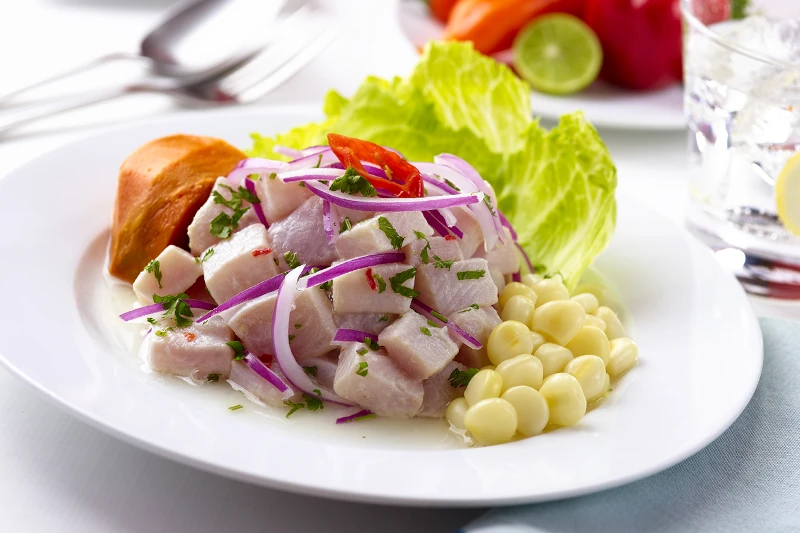
Pisco Sour: Peru’s Signature Cocktail
No exploration of the Famous Peruvian Dishes would be complete without a taste of the country’s national cocktail, the Pisco Sour. This refreshing drink is a delightful blend of sweet and sour flavors, perfect for sipping on a warm day.
The cocktail is made with pisco, a type of grape brandy produced in Peru. Lime juice, syrup, and egg white are into the pisco, then the mixture is shaken until frothy. A few drops of bitters are on top as a finishing touch.
The Pisco Sour is a perfect example of the balance found in Peruvian cuisine. The lime is tart, the syrup is sweet, and the pisco is strong. Together, they make a tasty drink.
The Staple Grains: Quinoa, Corn, and Potatoes
Peruvian cuisine is rich in grains and tubers, with quinoa, corn, and potatoes playing a central role. These staples are the backbone of many traditional dishes, providing sustenance and versatility.
Each of these ingredients has a unique story to tell. They reflect the country’s agricultural heritage and its ability to cultivate a diverse range of crops. Let’s delve into the significance of these staple grains in Peruvian cuisine.
Quinoa: The Andean Superfood
Quinoa, a grain native to the Andean region, is a vital part of the Peruvian diet. It’s known as a superfood due to its high nutritional value.
This grain is incredibly versatile. It can be in soups, salads, desserts, and even beverages. Its mild flavor and fluffy texture make it a favorite among both locals and visitors.
The Many Faces of Peruvian Corn
Corn, or maize, is another staple in Peruvian cuisine. The country boasts a variety of corn types, each with its unique characteristics.
Choclo, for instance, is a type of large-kernelled corn often served as a side dish. Meanwhile, purple corn is used to make chicha morada, a popular sweet beverage.
Potatoes: Peru’s Gift to the World
Finally, we have the humble potato. This tuber is native to Peru, with the Andean region being its center of origin.
Peru is home to over 3,000 varieties of potatoes. From the earthy papa amarilla to the vibrant papa morada, each type brings something unique to the table. Potatoes are used in a myriad of dishes, showcasing the versatility of this beloved ingredient.
Street Food and Snacks: Anticuchos and Salchipapas
Street food is an integral part of Peruvian culture, offering a quick and delicious taste of the country’s culinary diversity. Two of the most popular street foods are anticuchos and salchipapas.
Anticuchos are skewers of marinated beef heart, grilled to perfection. This dish, of African origin, is a testament to Peru’s multicultural culinary heritage. The meat is tender and flavorful, often served with boiled potatoes and aji sauce.
Salchipapas, on the other hand, is a simple yet satisfying dish. It consists of sliced hot dogs and fries, often topped with ketchup, mayonnaise, and aji sauce. This fusion of Peruvian and Western fast food is a favorite among locals, especially as a late-night snack. Whether you’re exploring a bustling market or a lively festival, these street foods are a must-try.
Pollo a la Brasa: The Beloved Peruvian Rotisserie Chicken
Pollo a la brasa, or Peruvian rotisserie chicken, is a dish that has won the hearts of locals and tourists alike. This chicken is marinated in spices and herbs. It is slow-roasted over charcoal. This makes the skin crispy and the meat tender.
The marinade often includes ingredients like garlic, soy sauce, and Peruvian black beer, giving the chicken its unique flavor. It’s typically with thick-cut fries, salad, and a variety of dipping sauces, including the spicy aji verde.
Pollo a la brasa is a popular dish in Peru. It has its own national day, celebrated on the third Sunday of July. Whether you eat at a fancy restaurant or a local chicken place, you should try this dish in Peru.
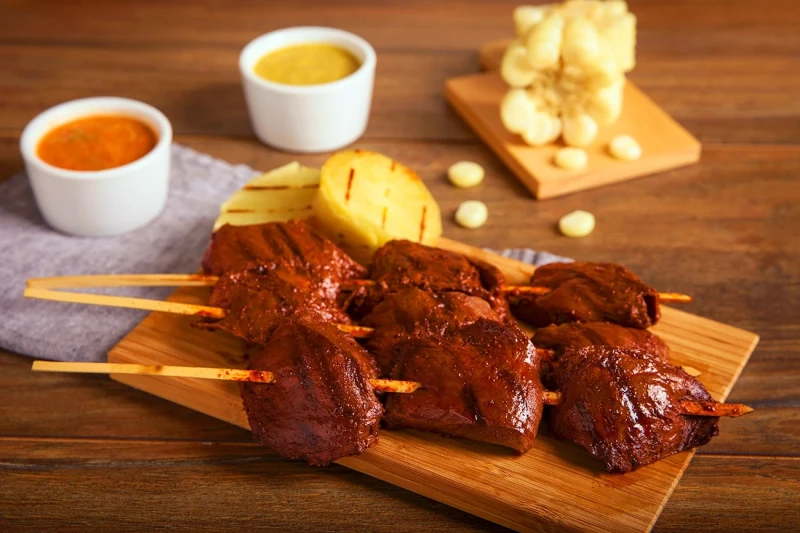
Regional Specialties: From Coast to Amazon
Peru has many different landscapes. These include the Pacific coast, the Andes mountains, and the Amazon rainforest. This variety creates many different types of regional foods. Each region boasts its own unique dishes, reflecting the local climate, culture, and available ingredients.
These regional specialties offer a fascinating glimpse into the country’s culinary diversity. They show the skill and creativity of Peruvian cooks. These cooks use local ingredients to make tasty dishes that reflect their culture.
Coastal Delights: Seafood and Chicha Morada
Peru’s coastline is renowned for its fresh seafood. Here, you’ll find dishes like tiradito, a raw fish dish similar to ceviche but without onions. Another coastal delight is chicha morada, a refreshing drink made from purple corn, pineapple, cinnamon, and cloves.
Chicha morada is a non-alcoholic accompaniment to meals. Its sweet, fruity flavor and vibrant purple color make it a favorite among locals and visitors alike.
Andean Pride: Cuy and Pachamanca
In the Andean region, cuy, or guinea pig, is a traditional dish. It’s often roasted whole and served with potatoes and corn. Pachamanca, another Andean specialty, is a feast of meats, potatoes, and corn cooked in an earth oven, a cooking method dating back to Inca times.
These dishes show how the Andean people connect with the land. They respect the natural resources it offers.
Amazonian Uniqueness: Juane and Tacacho
In the Amazon region, the cuisine features ingredients like plantains, yuca, and a variety of tropical fruits. Juane is a common dish from the Amazon. It has rice, meat, olives, and eggs. All these ingredients are in a bijao leaf and boiled.
Tacacho, another Amazonian specialty, is a dish of mashed green plantains mixed with chunks of pork. These dishes offer a taste of the Amazon’s rich biodiversity and the culinary traditions of its indigenous communities.
Peruvian Desserts Among Famous Peruvian Dishes
Peruvian cuisine isn’t just about savory dishes. The country’s desserts are equally enticing, offering a sweet conclusion to any meal. From creamy puddings to crumbly cookies, Peruvian desserts are a treat for the senses.
These desserts often feature local ingredients, such as lucuma, a native fruit with a unique, sweet flavor. They also showcase the influence of Spanish and other European cuisines, with ingredients like condensed milk and vanilla frequently used.
Alfajores and Suspiro a la Limeña
Alfajores are a popular Peruvian dessert. These sweet biscuits have manjar blanco, a creamy caramel-like filling similar to dulce de leche. They’re have powdered sugar, adding an extra touch of sweetness.
Suspiro a la limeña is another delicious dessert. Its name translates to “sigh of a woman from Lima,” reflecting its delicate, light texture.
This dessert has a base of manjar blanco. It has fluffy meringue. This creates a nice mix of textures and flavors.
Enjoying Typical Peruvian Meals Responsibly
As we’ve seen, traditional Peru dishes are a vibrant tapestry of flavors, traditions, and influences. It’s a reflection of the country’s rich history and diverse landscapes. But it’s also a cuisine that’s evolving, adapting to the challenges of the modern world.
Embracing Peruvian flavors means more than just enjoying the food. It’s about understanding the culture and history behind each dish. It’s about appreciating the hard work of the farmers and chefs who bring the Famous Peruvian Dishes to our tables.
So, whether you’re planning a trip to Peru or just exploring its cuisine from home, remember to do so responsibly. Support local businesses, respect the environment, and be open to new experiences. After all, that’s what travel and food are all about.
